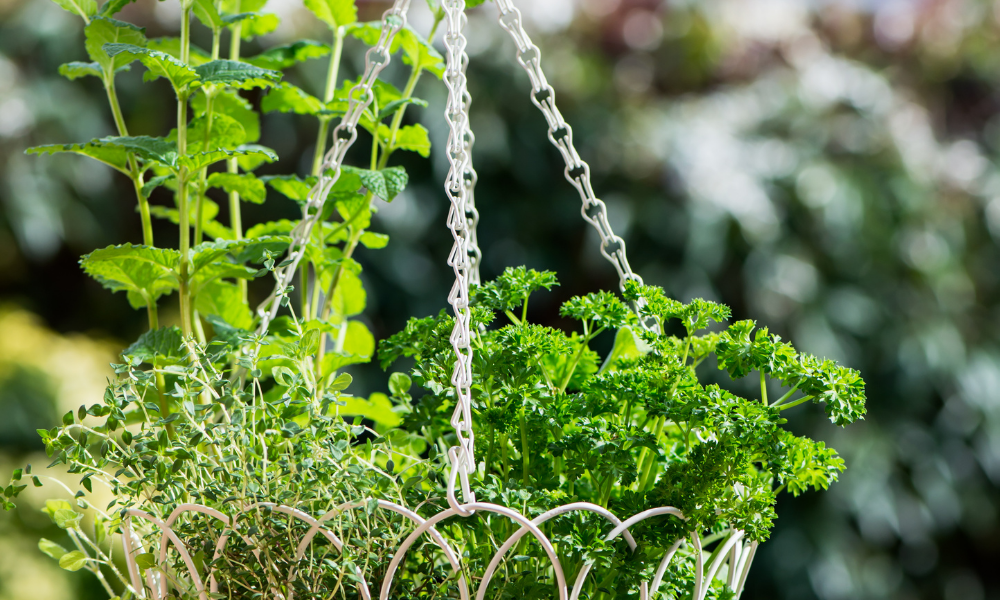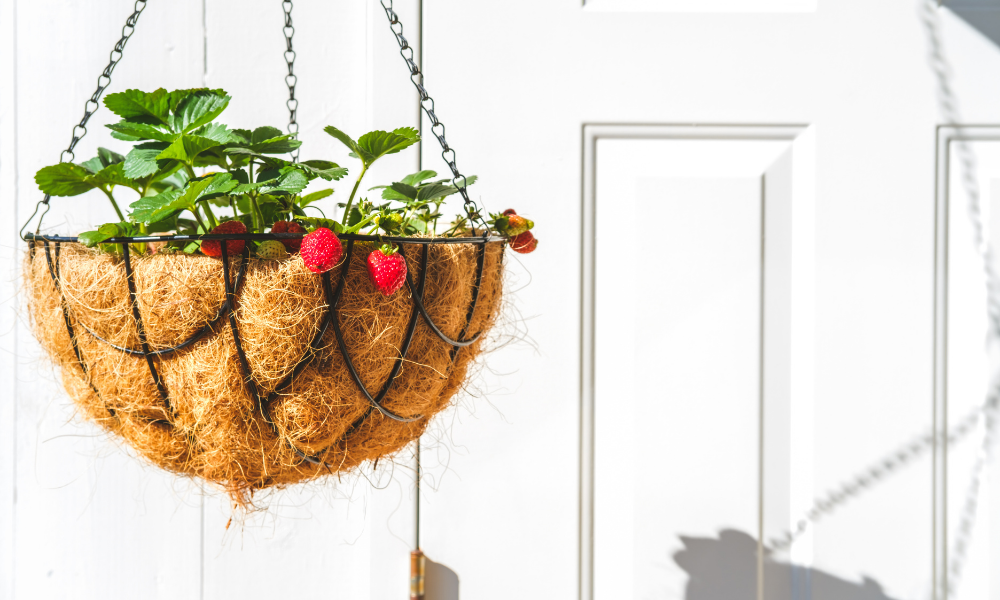Move over, flowers—hanging baskets aren’t just for decor anymore. They can also be used to grow some of your favorite fruits and vegetables!
Keep reading to learn which fruits and vegetables you can grow in a hanging basket?
But first…
Why grow fruits and vegetables in a hanging basket?
Hanging baskets make for a great gardening option for a number of reasons:
- They allow folks who don’t have space for an in-ground garden to still enjoy their own homegrown produce.
- They keep your bounty out of the destructive reach of slugs, snails, rabbits, deer, and other vermin.
- They are an attractive way to add a touch of green to your patio or balcony.
3 Fruits & Vegetables You Can Grow in a Hanging Basket
Strawberries
Strawberries are a popular option to grow in your hanging basket.
But not all strawberry varieties will do. Strawberries that send out runners are a no go—you want varieties that are compact and produce small fruit. For this reason, avoid June Bearing varieties.
Day-neutral strawberry varieties like Albion, Evie, Tristar, Tribute, and Mara de Bois are all great options. Day-neutral strawberries are ever-bearing and will produce fruit all summer long. Yes, please!
Strawberries will need 6 – 8 hours of direct sunlight each day. But if the heat becomes too intense, move to a shaded area.
Tomatoes
Large sliceable tomatoes are too heavy to grow in hanging baskets, so stick to small. Dwarf, cherry, and grape varieties do best. There are even “tumbler” varieties of tomatoes, which—as you might guess—tend to do well in hanging baskets, tumbling over the edges in a pretty fashion.
When choosing the appropriate size hanging basket, the bigger, the better for tomatoes. The root systems of tomatoes like room to spread, so choose a basket that’s between 12 – 24 inches in diameter and deep enough to hold at least 5 gallons of soil.
Tomatoes also are sun-lovers, needing 8 hours of direct sunlight a day. A sunny spot on the south side of your home is just what the tomato doc ordered.
 Herbs
Herbs
Herb lovers with limited garden space, rejoice! You can successfully grow herbs in a hanging basket.
Although I have personally never grown vegetables in baskets, I have grown herbs. Growing mint in a basket is a great way to keep it contained so that it doesn’t invade your garden.
I usually put several plants in a basket and then pinch the tops to keep the plants bushy instead of tall. This thread on reddit.com gives you easy step-by-step pictures to learn how to pinch.
Herbs that are suitable for hanging baskets include:
- Creeping thyme
- Prostrate rosemary
- Prostrate sage
- Nasturtium (leaves and flowers can be eaten)
- Feverfew (beautiful flowers and this herb can be used for treating migraines)
- Chives
- Mint
- Chocolate Mint
Many smaller herbs can be grown in baskets if you keep them trimmed well.
Additionally, basil is not a first choice for baskets, but you can keep it growing by keeping it trimmed.
Herbs enjoy full sun, so once again, the southside of your home is the best spot for happy herbs. Be sure to place the basket at a level that makes for easy sprig-snipping.
Other Vegetables You Can Grow in a Hanging Basket
Looking for more fruit and veggie options to grow in hanging baskets?
- Lettuce (a cool-weather vegetable)
- Eggplant
- small peppers
- Mustard Greens
- Kale
- Cabbage
- Radishes
These can also grow in hanging baskets with the right amount of TLC.
A note on greens: These should be the non-bolting or slow-bolting varieties. Bolting is when the plant puts on a vertical growth spurt to flower and set seed before the vegetable is ready to harvest. Some gardeners have had success with keeping the greens and cooler weather veggies in part shade to slow the bolting process.
Choosing the Right Soil
Choose a well-draining potting soil mix that contains organic matter to hold moisture. This is important, since hanging baskets dry out quickly. If using a wire basket, line it with landscape fabric or moss to retain the soil.
Water Needs
Hanging baskets dry out more quickly than in-soil gardens. Therefore, they need to be watered daily. Gently soak your hanging baskets using a watering can or hose head that disperses droplets.
If you forget to water them and they appear particularly parched, you can soak the container in a shallow bit of water to rehydrate the soil.
Supporting Your Hanging Basket
Make sure your hanging basket’s support is anchored in tightly—the baskets can become heavier than you might think! For instance, a fully mature tomato plant with wet soil can weigh upwards of 50 lbs. Make sure the hook the basket is hanging from is screwed tightly into the ceiling and can bear quite a bit of weight.
Happy planting this summer season!


